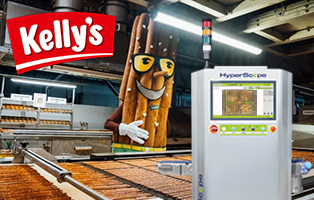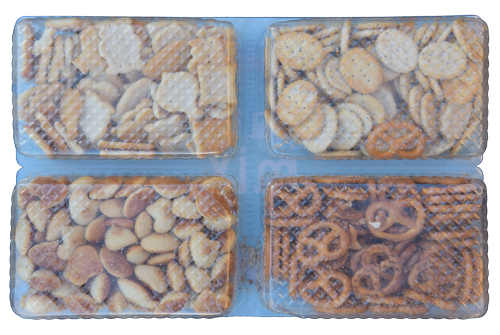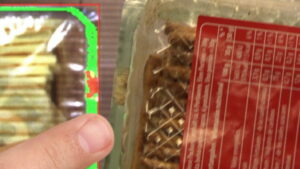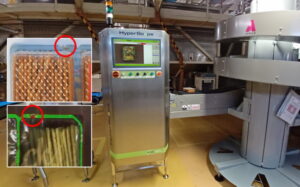
In-line hyperspectral seal inspection enables end-of-line automation for packaging snack trays
Since 1949, one of the most popular television and party snacks has been produced in Austria: the thin, salty pretzel sticks from the brand Soletti. Meanwhile Soletti became part of Kelly Snacks, and the successful product of flour, water, salt and yeast is exported to more than 40 countries. To keep up with the continuous growth, Kelly most recently invested in two new production lines for packaging various types of trays. A key element for these salty snacks is to preserve the crispiness, so seal integrity is critical. That’s why Kelly also integrated two new HyperScope® systems into these production lines, for fully automatic and 100% in-line seal inspection of the single- and multi-compartment trays with transparent as well as printed films.
DOWNLOAD PDF

Soletti’s product assortment has been extended over the years, offering a host of tasty nibbles and snacks, packaged in various formats, such as bags, trays, flow-packs and cups. Soletti is committed to use raw Austrian ingredients and sustainable production methods – an indispensable approach for an unbeatable flavor.
In 1985, Kelly acquired Soletti’s “Feldbacher Backwarenfabrik”, which was the largest baking production line for salt sticks in Europe at the time. In 2008, Kelly joined the Intersnack Group and Feldbach became the European Center of Excellence for baked products within the Kelly and Intersnack Group from 2010-2020.
“With 12,000 tons per year, Kelly is one of the largest industrial buyers of Austrian flour from Pregarten near Linz, Schwechat and Klagenfurt. The salt is sourced exclusively from the Salinen company in Ebensee in the Austrian Alps and processed at the plant.”, explains Mr. Matthias Stoessl, “Every day, 50 million salted sticks go through the baking line. The Soletti Pretzel recipe is a closely guarded secret, as is the production process.”
A diverse range of packaging
Snacks are packaged in different variations for many occasions: small personal treats, movie portions or bigger sized servings for families and parties. This requires different packaging formats such as flow-packs, VFFS (gusseted) bags, cups or thermoform trays with multiple compartments. To guarantee best-before dates and offer an appealing product, seal inspection is essential to avoid leaking packages or visible product particles in the sealing area. As the demand for snacks in trays is growing, Kelly decided to expand/upgrade their production capacity with new fully automated lines for packaging single trays, dual trays, or even quadruple trays with a mixed variety of snacks.
As seal integrity is equally important for these types of trays, Kelly was looking for a solution to inspect in-line 100% of the seals and automatically remove faulty packages, overall reducing manual labor for inspection and sorting. Defective packages lead to internal and external quality problems and high sorting costs, which of course need to be avoided.
Challenges with crispy snacks
 There are different challenges with this type of product and its packaging. As the salted product is crispy there are crumbles that might get stuck in the sealing area. When these particles are small, they have a limited effect on seal integrity. But larger parts can result in a seal breach.
There are different challenges with this type of product and its packaging. As the salted product is crispy there are crumbles that might get stuck in the sealing area. When these particles are small, they have a limited effect on seal integrity. But larger parts can result in a seal breach.
As the top film of the packages is often printed, contamination cannot be “seen” by a human eye or standard vision inspection systems. Inspecting with a camera from the bottom is also not a solution as the crumbles are hardly visible as there is typically a low contrast between the crumbles and the pale underside of the film, and certainly not when the tray is opaque.
Also, at a high production rate, manual inspection is simply not feasible. Finally, with multi-compartment trays there are often issues with product particles in the bridge. Also in this case, viewing or inspecting from below is difficult as the steep walls of the trays easily block the view of camera. So ideally, Kelly was looking for a solution that was: 1) capable of detecting contamination ; through printed top film; 2) usable for multi-trays; 3) capable of handling high production speeds and; 4) automatically rejecting faulty packages.
Enters HyperScope®, Engilico’s new solution for hyperspectral-based seal inspection of rigid trays and thermoforms.
Convincing remote demonstration
Kelly was already familiarized with Engilico’s solutions for seal inspection of flexible packaging. When Engilico introduced a revolutionary seal inspection system for rigid trays in 2021, Kelly was immediately interested in performing tests as they were planning to automate the inspection of their tray production lines. During that time however, the Corona pandemic was imposing severe restrictions on travelling and visiting customers on-site; a remote demonstration was organized using different types of packages that were sent to Engilico HQ for testing. After a successful demonstration, Kelly decided to equip their production lines with two of these unique hyperspectral seal inspection systems.
Seeing more with hyperspectral imaging and AI
 HyperScope® uses hyperspectral imaging to detect seal contamination with high contrast, even with printed film. The inspection system features GPU-accelerated artificial intelligence (AI), which enables real-time, high-precision seal area detection, regardless of the package orientation, packaging material, layout and size. The system includes a conveyor belt that can be completed with an integrated reject unit.
HyperScope® uses hyperspectral imaging to detect seal contamination with high contrast, even with printed film. The inspection system features GPU-accelerated artificial intelligence (AI), which enables real-time, high-precision seal area detection, regardless of the package orientation, packaging material, layout and size. The system includes a conveyor belt that can be completed with an integrated reject unit.
Hyperspectral cameras capture information from a larger part of the electromagnetic spectrum including infrared wavelengths that penetrate through thin plastic or paper top films. Hyperspectral imaging, therefore, unlocks new inspection possibilities where classic imaging often falls short, e.g., on printed film packages which are often used in the range of premium products with luxury packaging, on packaging with opaque backings or in applications where the seal contamination is difficult to detect due to limited contrast. The system can inspect up to 160 packages per minute, a speed that is well aligned with sliced, chopped and/or bulked-food production lines.
In-line seal inspection using hyperspectral imaging is challenging – as packages on the conveyor belt have different orientations. Moreover, the package surface might also be slightly deformed, especially when lighter materials are used – a trend nowadays to reduce plastic waste. Since contamination only needs to be detected in the sealing area, it is particularly important to detect this region with high accuracy. HyperScope® relies on artificial intelligence for this task: the sealing area is automatically determined, regardless of package orientation, degree of deformation and number of tray compartments.
The detected sealing area is then further analyzed in several post-processing steps to detect e.g. seal breaches, contamination inclusions in the seal, etc. Finally, based on configurable decision criteria the package is accepted or rejected.
“It is very important for us that 100% of our production is inspected and packages with seal contamination can be removed from the packaging line.”, says the IWS Manager Mr. Matthias Stoessl, “Seal defects can have an impact on the freshness of the product. Also for aesthetic purposes, product inclusion in the sealing area is not acceptable.”
Smooth installation and deployment
 The internal conveyor was specifically designed to fit in the layout of the production line. As the tray packaging lines were newly configured, the installation was relatively straightforward, teaming with the professionals from Kelly as well as with an external third-party line integrator.
The internal conveyor was specifically designed to fit in the layout of the production line. As the tray packaging lines were newly configured, the installation was relatively straightforward, teaming with the professionals from Kelly as well as with an external third-party line integrator.
HyperScope® is capable of processing different products and variations, which is important as the packaging lines are producing for different brands. In total, more than 16 different product models were created and extensively validated. All daily inspection information for the different products is saved in a database that can be exported to many reporting formats.
“We are very pleased with the installation and deployment of the two HyperScope® systems. This is a very innovative inspection technology that is particularly suited for our multi-compartment packages with printed top film.”, concludes Mr. Stoessl, “The new fully automated packaging line that features metal detector, HyperScope® seal inspection and checkweigher, positions us at the forefront of production and inspection capabilities.”
Monitoring production quality and process
As 100% of the production is tested, HyperScope® also serves as a monitoring tool for the complete production and the packaging line. When an issue occurs earlier on the line, and packages with defective seals are detected, operators can immediately take corrective actions. As an example, such a case occurred when the parameters of the thermoforming machine were wrongly configured, due to changing of packaging formats: typically, before sealing, the filled trays are automatically cleaned with a brushing tool to remove crumbles, but due to a wrong setting of the height of the brush, an unusual increase of defective packages was detected by HyperScope® and operators could immediately correct the wrong height setting.
Being a center of excellence, other companies from the Intersnack Group are obviously very interested in following these latest innovations at the Feldbach production site.
